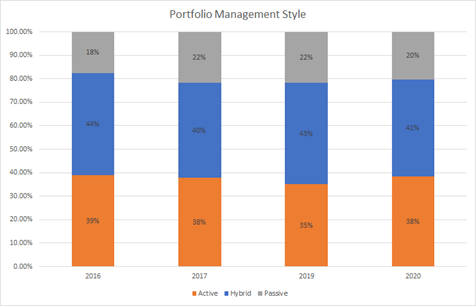The findings in this blog post come from our annual survey of around 1,800 registered investment adviser (“RIA”) firms conducted in the first quarter of 2021.
In this blog post, we focus on the adoption and the differences observed with RIA firms that utilize different portfolio management styles. Portfolio management style is defined as the primary investment management style that a firm uses to manage its clients’ assets: active, passive, or hybrid (a mix of both active and passive).
Portfolio Management Styles
RIA firms determine whether to manage client investment portfolios with an active, passive, or hybrid management style. An active approach generally implies buying and selling securities with the intent of outperforming an investment benchmark index. Firms that employ an active portfolio management style may utilize mutual funds, exchange traded funds, individual securities, or an array of other types of securities products, but regardless of the investment product being utilized, the firm is focused on trying to outperform an index.
A passive approach generally implies utilizing index funds or similar investment vehicles such as exchange-traded funds with the intent of mirroring an investment benchmark index. Hybrid firms, in regard to portfolio management style, are not absolute in their investment philosophy and may offer a mixture of passive and active portfolio management solutions to their clients (e.g. a core and satellite investment strategy).
Current Observations
In recent years, we have observed RIA firms’ trend towards using a passive or hybrid portfolio management approach. According to our survey results, 39% of RIA firms utilized an exclusively active portfolio management style in 2016 compared to 35% of RIAs in 2019. Alternatively, firms deploying an exclusively passive portfolio management style steadily increased from 18% of firms in 2016 to 22% in 2019. Advocates for passive portfolio management argue that such an approach allows an RIA firm to reduce complexity and increase scalability while often reducing performance volatility risk for its clients.
However, in our latest survey (reflected as 2020 in the chart below) we did see the trend towards a passive or hybrid investment management style shift a bit with an uptick in the number of RIA firms utilizing an active investment management style. In 2020, 38% of RIA firms utilized an exclusively active portfolio management style compared to 35% of RIA firms in 2019. Similarly, in 2020, 41% of investment advisory firms used a hybrid investment management style compared to 43% in 2019. It will be interesting to observe in the coming years whether this trend continues or if this was more of a short term anomaly due to the volatility in financial markets during 2020.
Despite the shift in 2020 towards a more active investment management style, our study shows that hybrid portfolio management is still the most common portfolio management style utilized by RIA firms:

Check back in the coming weeks as we continue to release more sneak previews from our upcoming investment adviser industry report on growth, technology, investment styles, and advisory fees.
